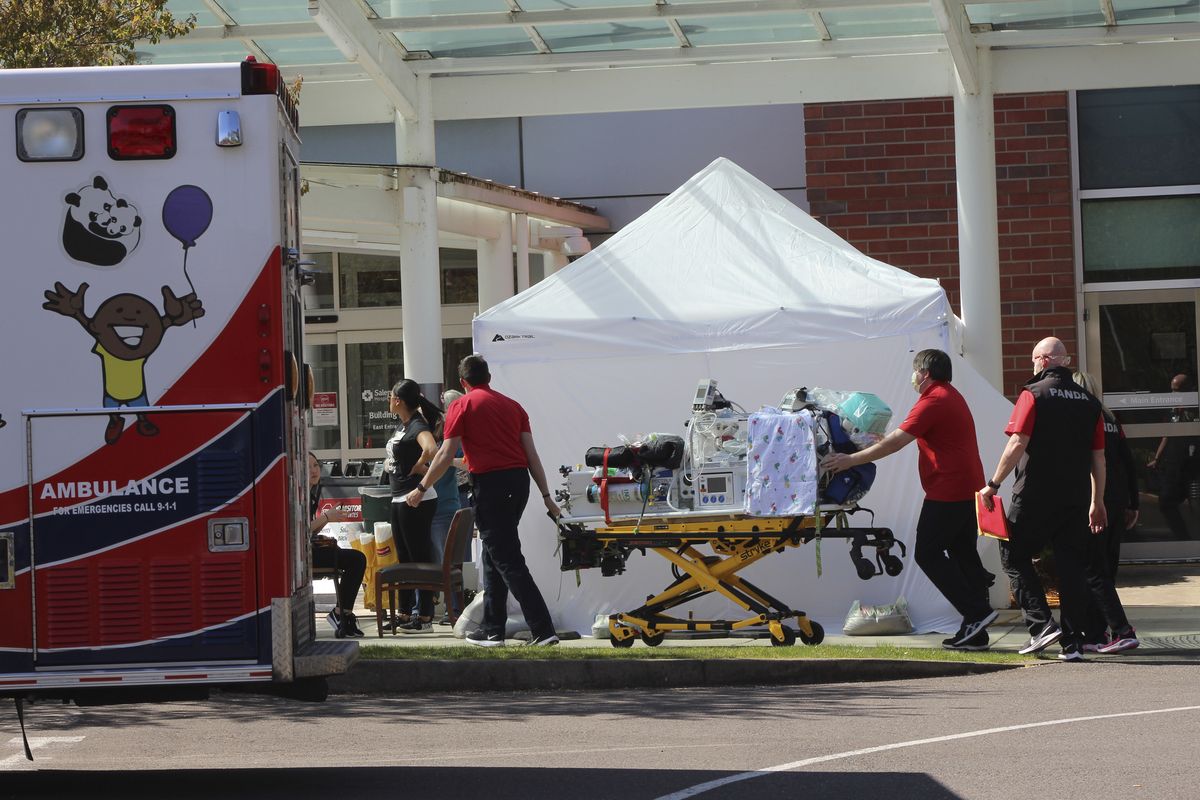Oregon could see “exponential growth” in COVID in worst case
FILE - In this April 9, 2020, file photo, healthcare workers wheeling a gurney into Salem Hospital's emergency room in Salem, Ore., during the coronavirus outbreak. Oregon health officials reported its second-highest tally of confirmed cases of COVID-19 and five additional deaths on Friday, June 26, 2020, the same day that authorities released new modeling that shows increased transmission of the coronavirus since the state began reopening in mid-May. (Andrew Selsky)
PORTLAND – Oregon health officials reported 250 confirmed cases of COVID-19 on Friday – its second-highest tally – and five additional deaths on the same day that authorities released new modeling that shows increased transmission of the coronavirus since the state began reopening in mid-May.
The modeling from the Oregon Health Authority and the Institute for Disease Modeling – based on data collected through June 18 – found that the virus transmission rate increased 15% after May 15 and another 10% after May 22, the start of the Memorial Day weekend.
There was another increase in confirmed cases around June 11, but health officials aren’t sure yet if those numbers are the result of changes in virus testing or the result of increased virus transmission.
Because of that uncertainty, based on the new data, the OHA and the Institute prepared three potential scenarios that take into account different levels of both increased testing and increased transmission to explain the rise in confirmed cases and predict possible trends.
The researchers warned of the possibility “exponential growth in new infections” by July 16 under a worst-case scenario.
In the most optimistic scenario, the increase in confirmed cases is from more testing alone – a scenario that the modeling authors called the least likely because “presently about one-third of new infections cannot be traced to a known source.” Under this modeling, case counts would remain stable at about 180 confirmed cases a day over the next month with no rise in hospitalization rates.
The moderate scenario attributes more confirmed cases to increased transmission and expanded testing. In that case, projections indicate that daily confirmed cases of COVID-19 could rise over the next month to more than 900 per day, with daily hospitalizations rising from eight to 27.
The worst-case scenario, based only on increased transmission rates, projects that confirmed daily cases could rise as much as 20 percentage points, to 4,852 new infections a day, and hospitalizations could increase by 74 per day for a total of 82 daily hospital admissions.
Dr. Dean Sidelinger, Oregon’s state health officer, called the modeling a “sobering reminder” that the coronavirus has not disappeared from Oregon and said Oregonians need to continue social distancing and to wear masks even in summer. The upcoming July 4 holiday presents a particular challenge, he added.
“Think hard about your choice of activities, especially as we get close to the Fourth of July holiday. Ask yourself: How can I reduce my risk and the risk I might pose to people around me?” he said.
The five deaths announced Friday were in Marion, Union and Morrow counties.
The death of a 90-year-old woman in Union County was the first in that county, which has been struggling to contain an outbreak that started at a church near La Grande. The number of confirmed cases in Union County also surpassed 300 on Friday.
On Friday, Gov. Kate Brown also made face masks mandatory in public, indoor spaces in Clatsop County starting Wednesday. That requirement is already in effect in Oregon’s seven other hardest-hit counties, including the Portland metropolitan region.

